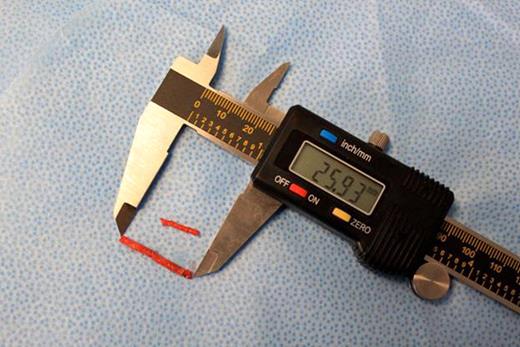Abstract
A battery-powered bone marrow biopsy system was cleared by the U.S. Food and Drug Administration in 2007 for bone marrow sampling. A study was designed to determine if the powered device has advantages over traditional manual devices in terms of decreased pain, insertion time, and improved sample yield.
The study protocol was approved by IntegReview Institutional Review Board. The study was conducted in a community cancer center. Pain-free adult volunteers, not on analgesics or anxiolytics, were enrolled in the study. Patients were not informed which needle was proprietary or being used with each procedure. Noise cancelling headphones and sham drill sound during manual insertions were employed. They were also uninformed as to which device was proprietary. After history, physical (including complete blood count) and consenting procedures, volunteer subjects were randomized to first pass device type and first-pass procedure side (left or right). Following local anesthesia administration using buffered Lidocaine, device operators (board-certified in hematology/oncology) performed the procedures using a Jamshidi® 11 gauge/4” Manual bone marrow biopsy needle (Havel, Inc. Richmond, VA) and an OnControl™ 11 gauge/102mm Powered bone marrow biopsy needle (Vidacare Corporation, Shavano Park, TX). A 100mm visual analog scale (VAS) was used to assess pain at initial biopsy needle insertion through the cortex, needle advancement for core sample capture, and needle removal—followed by a VAS measurement of the overall procedure pain and a final check 30 minutes after the procedure. After the second procedure, subjects were given a chance to change their overall pain score for the first procedure (“second look overall pain score”). Follow-up assessment for VAS and complications were made 1 day, 2 days, and 7 days after the biopsy procedures. Procedure time was measured from needle-to-skin contact to core specimen ejection from the needle. Core specimens were measured for length and submitted to pathology reference laboratory for grading. Pathology assessment included size measurement, post-fixation quality, medullary component quality, and overall quality.
There were 24 evaluable subjects the study. The mean age was 33.8 ± 11.3 years, and 54.2% were male. Mean height and weight were 169.7 ± 10.8cm and 77.0 ± 17.7kg, respectively. Of the 24 evaluable subjects, there were 24 manual insertions and 24 powered insertions. Cores were obtained in 67% of the Manual insertions and 100% of Powered insertions—a significant difference (p=0.002). The mean time to core acquisition was 86 seconds for Manual device and 47 seconds for the Powered device, a significance difference (p<0.001). Using the second look overall pain score (for those that opted to change their score), the mean score for the Manual device was 33.3 and 20.9 for the Powered—a significant difference (p<0.05). There was no statistical or clinical difference in other pain scores between the two devices. The mean biopsy core length was 11.1 ± 4.5mm for the Manual device and 17.0 ± 6.8mm for the Powered device (Figure 1); a statistical difference (p<0.005). Pathology assessment for the Manual device showed mean length of 6.08 ± 5.59mm, width of 0.98 ± 0.74mm, and mean volume of 11.00 ± 10.76mm3. Measurements for the Powered device were mean length of 15.29 ± 6.12mm, width of 1.98 ± 0.31mm, and mean volume of 49.12 ± 21.45mm3. All differences were statistically significant with p-values <0.001. For overall quality, 33.3% of Manual samples and 79.2% of Powered samples were graded adequate—a statistical difference (p=0.002). There were no complications.
Results suggest the superior size and overall quality of core specimens delivered by the Powered device may provide more material for pathological evaluation of hematopoietic and oncological disorders. The powered device was significantly faster in obtaining a biopsy than the manual device and its capture rate in obtaining a satisfactory sample was much higher. Use of the Powered bone marrow biopsy device significantly decreases overall procedure pain.
Demonstrates bone marrow core samples obtained from one subject using Manual biopsy device (upper sample) and Powered biopsy device (lower sample).
Demonstrates bone marrow core samples obtained from one subject using Manual biopsy device (upper sample) and Powered biopsy device (lower sample).
Miller:Vidacare Corporation: Employment, Equity Ownership, Patents & Royalties. Philbeck:Vidacare Corporation: Employment. Montez:Vidacare Corporation: Employment. Puga:Vidacare Corporation: Employment. Brenner:Vidacare Corporation: Consultancy, Research Funding. Cohen:Vidacare Corporation: Consultancy, Research Funding.

This icon denotes an abstract that is clinically relevant.
Author notes
Asterisk with author names denotes non-ASH members.


This feature is available to Subscribers Only
Sign In or Create an Account Close Modal